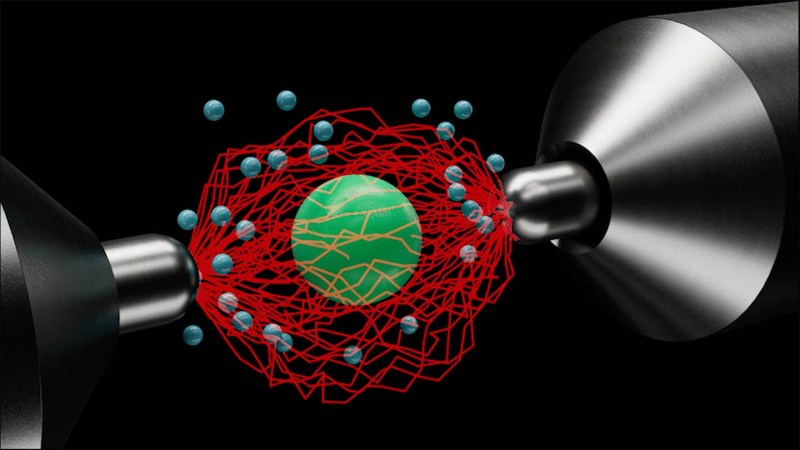Science
Tiny Glass Sphere Operates as World’s Hottest Engine at Microscale

A team of researchers has developed an innovative engine composed of a minuscule glass sphere measuring just 5 micrometers across, demonstrating extraordinary properties at extreme temperatures. This remarkable creation, levitated in a near-vacuum using an electric field, behaves as if it reaches a temperature equivalent to an astonishing 13 million Celsius, nearly matching the core temperature of the sun. The findings, set to be published in Physical Review Letters, reveal intriguing insights into the physics of heat at the microscale.
The behavior of this glass sphere challenges conventional definitions of temperature and engines. Unlike typical engines that convert heat into mechanical work, this sphere’s effective temperature stems from its overall motion rather than from the thermal agitation of individual molecules. According to co-author and physicist James Millen of King’s College London, “It is moving as if you had put this object into a gas that was that hot.” This unique motion provides a vivid illustration of how microscopic objects can behave under extreme conditions.
Researchers highlight the significance of this experiment, particularly in terms of efficiency. The sphere operates as a heat engine, a type of machine that utilizes heat from a high-temperature source while expelling waste heat to a lower-temperature sink. Typically, commercial engines achieve a temperature ratio of around 3, yet this novel engine boasts an impressive ratio of approximately 100. Such high-temperature ratios could pave the way for advancements in engine efficiency.
Understanding the behaviors of this engine at such a small scale reveals the complexities of thermodynamics. The team observed significant fluctuations in performance, with efficiency varying dramatically—sometimes reaching 200 percent efficiency. In other instances, the engine even appeared to operate in reverse, cooling down instead of heating up. Millen reflects on these findings, stating, “Thermodynamics down at the microscale is really, really weird. I really think it’s as unintuitive as something like quantum mechanics.”
The implications of this research extend beyond theoretical physics. The microscopic behavior observed in the glass sphere could offer insights into biological processes. Tiny structures like proteins within cells are similarly affected by random motions in their environments. The researchers aim to apply their findings to better understand biological engines such as kinesin, a motor protein responsible for transporting cargo within cells.
While the glass sphere does not perform practical tasks typical of conventional engines, Millen describes it as a “perfect analog of an engine,” enabling scientists to explore fundamental principles of motion and energy at microscopic levels. As the particle interacts with the electric field, it experiences position-dependent diffusion, a phenomenon crucial for biological functions like protein folding.
Physicist Uroš Delić from TU Wien in Vienna, who was not involved in the study, acknowledges the significance of combining extreme temperature, a high hot-to-cold temperature ratio, and position-dependent diffusion in a single experiment. “This work combines all three, so that’s quite cool— or hot,” he remarked, underscoring the groundbreaking nature of the research.
As scientists continue to unravel the complexities of thermodynamics at the microscale, this tiny glass sphere stands as a testament to the fascinating world of physics and its potential applications in understanding biological systems. The ongoing exploration of these phenomena could ultimately lead to breakthroughs in various fields, including materials science and biotechnology.
-

 Science3 weeks ago
Science3 weeks agoALMA Discovers Companion Orbiting Giant Red Star π 1 Gruis
-

 Top Stories2 months ago
Top Stories2 months agoNew ‘Star Trek: Voyager’ Game Demo Released, Players Test Limits
-

 Politics2 months ago
Politics2 months agoSEVENTEEN’s Mingyu Faces Backlash Over Alcohol Incident at Concert
-

 World2 months ago
World2 months agoGlobal Air Forces Ranked by Annual Defense Budgets in 2025
-

 World2 months ago
World2 months agoElectrification Challenges Demand Advanced Multiphysics Modeling
-

 World2 months ago
World2 months agoMass Production of F-35 Fighter Jet Drives Down Costs
-

 Business2 months ago
Business2 months agoGold Investment Surge: Top Mutual Funds and ETF Alternatives
-

 Science2 months ago
Science2 months agoTime Crystals Revolutionize Quantum Computing Potential
-

 Top Stories2 months ago
Top Stories2 months agoDirecTV to Launch AI-Driven Ads with User Likenesses in 2026
-

 Entertainment2 months ago
Entertainment2 months agoFreeport Art Gallery Transforms Waste into Creative Masterpieces
-

 Health2 months ago
Health2 months agoGavin Newsom Critiques Trump’s Health and National Guard Plans
-

 Business2 months ago
Business2 months agoUS Government Denies Coal Lease Bid, Impacting Industry Revival Efforts









